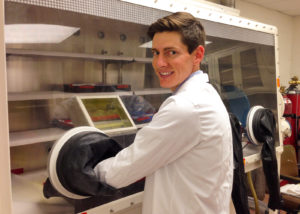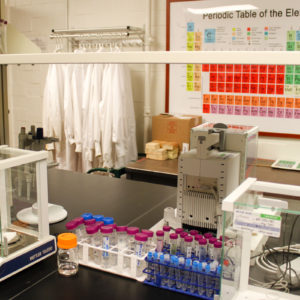
Nuclear forensics involves using analytical techniques to determine the origin and history of nuclear materials, in particular those that have been intercepted from smuggling operations or recovered following a nuclear explosion. According to Jeremy Osborn, a nuclear engineering Ph.D. student working with the Texas A&M Engineering Experiment Station’s Center for Nuclear Security Science and Policy Initiatives (NSSPI), “the growing concern regarding nuclear terrorism has heightened the need to develop nuclear forensics analysis techniques that allow nuclear material source attribution, and thereby strengthen nuclear deterrence.”

Osborn is part of a team of researchers at NSSPI who have been working on a project to develop new methods to determine the reactor origins of weapons-grade plutonium. Dr. Sunil Chirayath, director of NSSPI, has led this seven-year project, which was funded by the U.S. Department of Homeland Security’s Domestic Nuclear Detection Office under an Academic Research Initiative (DNDO-ARI) grant, in conjunction with Dr. Charles M. Folden III of the Cyclotron Institute. This project has brought a much-needed nuclear forensics capability to NSSPI and has led to the training of many graduate students in this crucial field. This year, Osborn and fellow Ph.D. student Paul Mendoza will be the latest students to earn their doctorates through this project, which has already generated three master’s degrees, another Ph.D. and research experience for three undergraduates.
Up to now, “pre-detonation nuclear forensics for chemically separated weapons-grade plutonium has been limited to estimating the time since last chemical separation,” Mendoza said. “This project provides a means and methodology, developed and tested, for determining much more.”
“Much more” includes determining characteristics of the material in question like the reactor type, irradiation history, burnup and scalar neutron flux magnitude the material saw in the reactor. This information could help pinpoint the origins of the material, which Mendoza notes would be “important in a national security context if such a material were to be interdicted from a U.S. adversary.”

The researchers used a radiochemistry technique utilizing plutonium uranium oxidation-reduction (redox) extraction to separate the plutonium from the trace elements in spent nuclear fuel. NSSPI has developed the first capability for bench-scale plutonium uranium redox extraction (PUREX) reprocessing of plutonium at a U.S. university. They used a Gaussian maximum-likelihood reactor-type discrimination process for the forensics methodology development.
Osborn and Mendoza built on the work of past NSSPI graduates to investigate two different methods for discriminating the separated plutonium from various reactor-types using the forensics methodology developed as part of this DNDO project. Mendoza’s project focused on forensics methodology that uses destructive analysis to investigate the trace contaminants in plutonium recovered using the PUREX process, which could give clues to the conditions under which the plutonium was produced. Osborn developed a non-destructive forensics technique based on using intra-element isotope ratios to determine the reactor type. Both methodologies were verified through both experimental and computational means.
Mendoza graduated with a Bachelor of Science degree in nuclear engineering from Biola University. He successfully defended his dissertation in October of 2017 and will be receiving his Ph.D. in May 2018. He currently works as a postdoctoral researcher at Los Alamos National Laboratory. Osborn has both a Bachelor of Science degree and a Master of Science degree in nuclear engineering from Texas A&M and is planning to defend his dissertation and graduate in August 2018.
For more information on this project, visit NSSPI’s website.
